INTRODUCTION
Quail farming has shown a rapid development in recent years due several advantages such as fast growth, small areas to raise the birds, early sexual maturity, high egg production, low feed intake and high resistance to diseases. In order to reduce production costs, poultry industry increases birds stocking density as alternative to improve flock profitability (Lima et al., 2012).
In commercial poultry facilities, growing birds in cages on high density has become a common issue in management, aiming to reduce both stocking costs and equipment per bird. However, the area reduction per bird as well as feeders and drinkers, can cause stress problems due to bird’s competitive behavior (Janczak and Riber, 2015), which impact on feed consumption and, as consequence, in growth and productive performance traits.
Domestic quails still have many wild birds’ characteristics, and the confinement intensifies perverse behaviours such as aggressive pecking, leading to feather pecking and cannibalism, increasing mortality and affecting the flock viability (Pelicia et al., 2019). To prevent such losses, quail egg producers implement beak trimming management, which consists in cutting and cauterizing bird’s beak to avoid, besides some stress behaviours, feed waste (Gonçalvez et al., 2010).
Less aggressive techniques have been studied and upgraded in recent years (Pereira et al., 2015) to ensure better productive conditions (Janczak and Riber, 2015). The evaluation of the effect of beak trimming management associated with stocking density providing comfort for the animal is needed. Hence, the objective of this study was to evaluate performance, egg quality and behaviour of laying Japanese quails kept in different stocking densities associated with trimming management during lying phase.
MATERIALS AND METHODS
The experiment was conducted at the Experimental Quail Farm of the Animal Science Department of Mato Grosso Federal University, in Santo Antônio do Leverger city during 84 days in three 28-day periods of measurements. The experimental protocol was approved by the Ethics Committee for the Use of Animals (CEUA) of the University, under protocol number 23108.187860/2016-11.
In total, 196 Japanese quails were randomly allocated to a 2 x 2 factorial scheme: submitted or not to beak trimming procedure and low (237.5 cm²/bird) and high stocking density (316.7 cm/bird) and its interaction. Eight replicates per treatment were used, totaling 32 experimental units. Beak trimming was performed at 30 weeks of age with hot blade beak trimmer, trimming 1/3 of the beak. The quails were housed in galvanized wire cages (experimental unit) measuring 50 x 38 x 21 cm (length x width x height). The quails received feed ad libitum, and water was offered three times a day (07:00, 13:00 and 17:00 h).
Lighting was provided for 16 hours per day during the whole experimental period. The light supply was controlled by a timer, which allows the lights to be turned on and off automatically during night, according to procedures used in commercial farms. Experimental diets (Table 1) were designed based on corn and soybean meal according nutritional requirements established by Rostagno et al. (2011).
Table 1 Calculated composition of expe- rimental diets
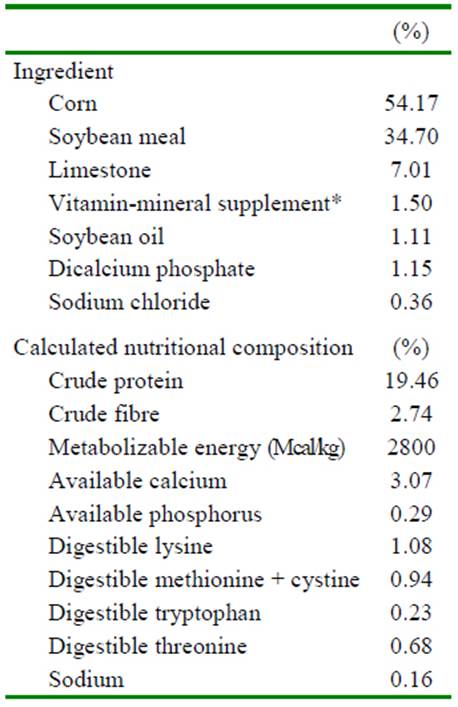
*Vitamin-mineral supplement composition: Calcium (min) 80 g/kg, Calcium (max) 100 g/kg Phosphorus (min) 37 g/kg, Sodium (min) 20 g/kg, Methionine (min) 21.5 g/kg, Lysine (min) 18 g/kg, Vitamin A (min) 125000 IU/kg, Vitamin D3 (min) 25000 IU/kg, Vitamin E (min)312 IU/kg, Vitamin K3 (min) 20 mg/kg, Vitamin B1 (min) 20 mg/kg, Vitamin B2 (min) 62.5 mg/kg, Vitamin B6 (min) 37.5 mg/kg, Vitamin B 12 (min) 200 mcg/kg, Folic acid (min) 6.25 mg/kg, Pantothenic acid (min) 125 mg/kg, Biotin (min) 1.25 mg/kg, Choline (min) 1700 mg/kg, Niacin (min) 312 mg/kg, Copper (min) 125 mg/kg, Iron (min) 680 mg/kg, Iodine (min) 8.75 mg/kg, Manganese (min) 937 mg/kg, Selenium (min) 3.75 mg/kg, Zinc (min) 500 mg/kg, Fluorine (max) 370 mg/kg
Performance parameters
The traits assessed were egg production (%), marketable eggs (%), feed intake (g/ quail/day), feed conversion per egg mass (kg/ kg), feed conversion per dozen of eggs (kg/ eggs dozen), mortality and body weight gain (g) (WG). Egg production percentage (eggs/ bird/day) was obtained by the number of eggs produced, including broken, cracked, soft shells and shell-less eggs produced in each experimental period. Marketable eggs were total egg production minus whole broken, cracked, soft-shell and shell-less eggs.
Feed consumption was determined by the difference between the ration intake and leftovers, corrected by the number of dead birds at the end of each 28-day period. Feed conversion per egg mass was calculated as FCm = C/EW and feed conversion per eggs dozen was calculated as FCdz = C/DZ where C = consumption, DZ: dozen of eggs produced, and EW: Egg weight. Balances with capacity of 15 kg (Toledo 9094) were used to weigh birds, feed and leftovers.
Viability was calculated by the total number of alive birds minus total number of dead birds expressed in percentage, and body weight gain was the difference of body weight at the beginning and end of the experimental and expressed in g/bird/day.
Egg quality
At the end of the last three days of each experimental period, three eggs per repetition were collected per day (3 eggs x 3 days x 3 periods x 4 treatments x 8 replicates in each) totalling 864 eggs for quality analysis (broken, cracked, soft shells and shell-less eggs were excluded). Analyses for weight average, Haugh unit, specific gravity, albumen height and yolk, shell and albumen weight and percentages were performed.
The specific gravity was determined by immersing the eggs in saline solution, with density ranging from 1.070 to 1.095 g/cm³ (0.005 g/cm³ I.C.), using a calibrated densimeter (OM-5565, Incoterm). Albumen height was performed using a digital calliper (Starret 150 mm). The Haugh (Hu) unit was obtained using the Brant et al. (1951) formula:

where: H = height of the dense albumen (mm); G = gravitational constant with value of 32; W = egg weight (g).
The egg yolk was separated from albumen and weighted. Shell weight was registered after being washed and exposed to natural drying for 72 hours. Albumen weight was obtained by the difference between whole egg weight and yolk and shell weights.
Behaviour
The ethogram was designed through observations along the experimental period (Table 2). After the first 28-day experimental period where birds were observed from 06:00 to 18:00 h (12 h), twice completing 24 hours of observation with 10-minute intervals. The instantaneous focal sampling method was used, where an animal from each experimental repetition is pre-identified and immediately evaluated, in the proposed period, every 10 minutes. Behavioural data were collected from 432 behavioural observations (10 minutes each hour for 24 hours = 144 behavioural observations, and this was done in three periods) into each treatment and registered as (1) when the behaviour occurred and (0) when the current evaluated behaviour was not observed in instantaneous focal sampling, looking for birds with leisure, comfort, interaction with feathers, eating, drinking, panting, interaction with cage and aggressiveness. The number of quails expressing each behaviour was expressed in frequency of occurrence (%). Only one person evaluated the behaviour of birds to avoid subjective variations.
Table 2 Japanese quail’s ethogram related to beak trimming process, combined with different stocking densities in laying phase
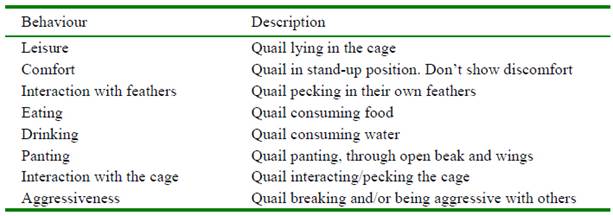
Performance and egg quality data were submitted to parametric analysis of variance with generalized linear model, and the means were compared by Tukey test at probability of 5%, when p<0.05, using Sisvar Program. For ethogram analysis, behavioural data were submitted for non-parametric analysis of variance in SAS® (v. 9.3) program, using a generalized hierarchical linear mixed model with the procedure GLIMMIX, considering response variable with binary distribution, where 1 indicated behaviour occurrence and 0 its absence in each quail.
The random effect considered the quail inside each treatment. Afterwards, if p<0.05 for fixed effects in the behavioural analysis, last square means were applied for post-hoc comparison between treatment percentages into each studied behaviour.
RESULTS
Feed consumption was affected by birds density (p<0.05; Table 3). Besides, there was no significant effect (p>0.05) of different densities, beak trimming and their interaction on quality eggs traits (Tables 3 and 4).
Table 3 Performance of Japanese quails in two cage densities and submitted or not to beak trimming procedure, during laying stage
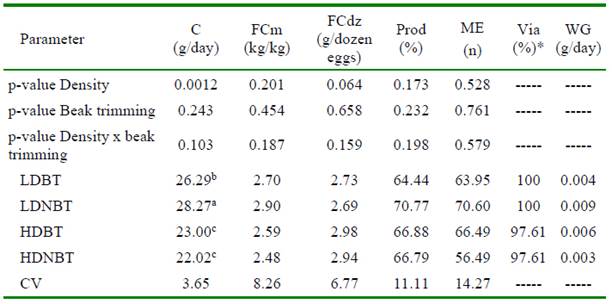
a,b,c Means followed by the same letter in a column do not differ significantly by Tukey test (p<0.05) LDBT= Low density and submitted to beak trimming; LDNBT= Low density and not submitted to beak trimming; HDBT= High density and submitted to beak trimming; HDNBT= High density and not submitted to beak trimming; CV: Coefficient of variation
C: Feed consumption (g/day); FCm: Feed conversion per mass (kg/kg); FCdz: Feed conversion per dozen eggs (g/dozen eggs); %Prod: Percentage of egg produced (%); ME: Marketable eggs (n); Via: Viability (%); WG: weight gain (g/day); * Descriptive analysis
Table 4 Japanese quails egg quality traits in two stocking densities and submitted or not
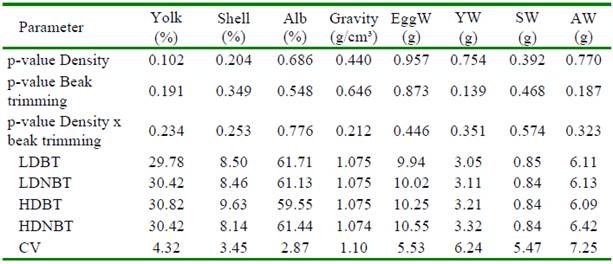
LDBT= Low density and submitted to beak trimming; LDNBT= Low density and not submitted to beak trimming; HDBT= High density and submitted to beak trimming; HDNBT= High density and not submitted to beak trimming. Yolk (%); CV: Coefficient of variation
Alb (%): Albumen percentage; Gravity: Specific gravity (g/cm³); EggW: Egg weight (g); YW: yolk weight (g); SW: Shell weight (g). AW: Albumen weight (g)
Birds housed in higher density had less leisure, comfort, interaction with feathers, and eating time (p<0.05) when compared to quails housed in a lower density. Also, laying quails housed in high density showed higher interaction with cage and aggressiveness. Drinking and panting did not show differences between treatments (Table 4).
DISCUSSION
Quails housed in high density showed lower feed intake, probably due to the higher number of animals per area, leading to greater competition for space in the feeders (Castilho et al., 2015); however, despite lower feed consumption in the high-density treatments, there was no significant difference in egg production, feed conversion by mass and dozens of eggs produced. These corroborate results found by Soares et al. (2018) working with various densities of Japanese quails with lower consumption in cages with small area per animal in the feeder.
Research about stocking density and debeaking effects in cages showed improvement in egg production and lower decreased when increasing available area per bird (Oka et al., 2017). In the present study, because higher and lower densities did not affect (p>0.05) most performance parameters, egg quail production with density up to 237.5 cm²/bird could be recommended.
Table 5 Japanese quail behaviour (%) housed in different densities and whether submitted or not to beak trimming procedure, during laying stage (n=400 observations)
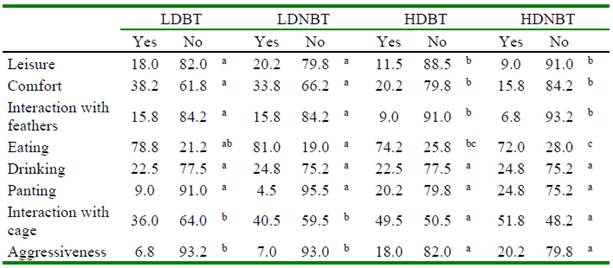
a,b,c Means followed by the same letter in a row do not differ significantly by Tukey test (p<0.05). LDBT= Low density and submitted to beak trimming; LDNBT= Low density and not submitted to beak trimming; HDBT= High density and submitted to beak trimming; HDNBT= High density and not submitted to beak trimming
High densities might be practiced with some precautions because decreasing feeder, drinker and movement areas decrease feed intake and feed conversion index (Janczak & Riber, 2015; Cardoso et al., 2017), but in addition, muscle and skeletal development can be negatively affected, as well as osteoporosis incidence and higher mortality might occur (Rios et al., 2009). On this respect, El-Tarabany (2015) recommend that during lying phase, quails should be housed in cages with an area up to 107.64 cm2/bird to achieve optimal performance. In the present research, the areas used were much larger (237.5 and 316.7 cm2/bird).
Beak trimming showed no effects (p<0.05) on performance. Carruthers et al. (2012) argued that beak trimming management is common for rearing laying hens and quails preventing cannibalism, mortality, injuries associated with feather pecking among birds, as well as decline the productive performance with less feed waste (greater feed conversion).
Pizzolante et al. (2006) reported that there was no influence of age on trimming beaks, and it can be performed with either at 14 or 21 days. Vieira Filho et al. (2016) found better results for feed intake, egg weight and mass in six weeks old laying hens submitted to beak trimming procedure when compared to those at ten weeks of age. Araújo et al. (2005) did not observe effect of beak trimming in chickens at days 10, 64 and 84 of age over productive parameters in commercial laying hens. Struthers et al. (2019) reported that beak trimming procedure affects young birds being less traumatic because their better recovery capacity compared to older birds. However, the same authors argue some laborious issues manipulating young birds, due the reduced beak size. In the present study, quails had their beak trimmed at week 30 of age, in production stage, and this did not interfere on animal performance.
Egg quality was not affected by the variables under study, as appears in literature recommendations, such as egg weight around 9.05 g, percentage of albumen, yolk and shell around 61, 30 and 9%, respectively (Lima et al., 2012), however, it is necessary to analyse other aspects such as animal behaviour and how much these processes can influence throughout quail’s production cycle. Behavioural changes among animals are observed in response to changes of their physiological parameters, and these changes, can influence their welfare. Thus, behaviour observations are useful to find improvements for animal welfare (Gonçalves et al., 2017).
Quails housed in higher density environments had longer panting time and greater aggressiveness due the stress. Gonçalves et al. (2017) reports that birds gasping is one of the most effective signal of heat loss and, if the relative humidity is appropriate, most birds will be able to dissipate their metabolic heat through this mechanism.
Laganá et al. (2011) reported that the laying rate increases when birds are submitted to beak trimming due to lower mortality and lower pecking egg index because of less aggressive behaviour. In the present study, even with the frequency of more aggressive behaviour and lower feed consumption for birds not submitted to beak trimming and at higher densities, there was no interference in laying quail’s total performance.












 uBio
uBio 


